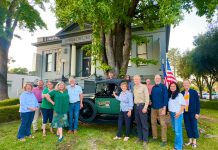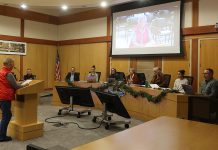By Chris Herrod
These views were prepared independently for the benefit of Councilmember Chris Herrod’s newsletter subscribers and may not necessarily reflect the views of other councilmembers.
The Growth Management Ordinance, the GMO, was adopted with good intentions. I voted for it myself, thinking it would safeguard “measured growth” and would protect our town from sprawl (in a 2000 city-wide election).
It might have done those things, but the unintended negative impacts are clear. We haven’t built a single multi-family rental (over 5 units) in the 24 years since voters adopted Healdsburg’s GMO. This failure has contributed partially to wildly escalating rents and home prices—and has certainly contributed to dwindling options for Healdsburg’s working-class majority.

Opening the GMO has long been suggested as a way to give housing developers the options needed to engineer financing. On the other hand, by excluding expensive single-family dwellings and by installing proper zoning rules and size limits, the City keeps the focus squarely on workforce housing as opposed to more luxury housing. We need feasibility and commitment from both sides of the equation to reach our goals.
At our June 3rd meeting the Council solidified a path that encourages workforce housing in specific areas, while maintaining the GMO throughout the neighborhoods, Plaza area and ridgeline.
We have finalized a ballot measure for Healdsburg’s voters that encourages housing that is best suited to Healdsburg’s workers: near the city center, close to transportation and jobs, and where higher density units make the most sense, both cosmetically and economically (and in accord with our climate goals). We will vote on whether to adopt the ballot language at our next meeting on June 17.
Coming to the Ballot
Under our proposal, the GMO would remain intact in our neighborhoods, around the Plaza and in much of the surrounding downtown areas—protecting retail properties and the character of our iconic downtown. Zoning changes and the development agreement process will add additional layers of protection against “runaway” luxury development.
The GMO would only be lifted along Healdsburg Ave. (north of North St. south of March Ave.), around the new train station area, and south of the bridge (which has no amenities such as water and sewer, and is not presently zoned for housing).
The ballot measure is simple, uncomplicated, and focused—with no worrisome small print or hidden agendas.
Inevitably, some have begun to issue warnings that any “lifting” of the GMO signals a takeover by developers, like the ones building the Mill District or Montage resort.
These well-meaning activists will tell you that “for every 5 units of market-rate housing built, one has to be built for lower-income residents” and that this is not enough. I fully agree that the 20% inclusionary requirement, though helpful, falls far, far short of answering our housing needs on its own. But building market-rate housing is not limited to that one benefit so long as we are effective at encouraging housing suited to our workforce. That’s our goal, plain and simple.
The proposed GMO modification, in addition to creating real opportunities here and now, is the best way to prepare us for when conditions become more favorable for housing development in the future. We can not be caught empty-handed (stifled by the GMO) when real opportunities to develop workforce housing present themselves.

Previous Efforts
There’s sometimes a claim that “other housing solutions” have been ignored, but most of the examples given have already failed (Measure P in 2018 and Measure H in 2020). Some are not legally possible (local preference for ownership).
Finally, some would provide a negligible impact, especially with regard to much-needed ownership opportunities. For example, we want ADUs (Accessory Dwelling Units, commonly known as “granny unit” infill) but there’s no way that their development can keep up with our needs, especially the way that multi-unit apartments can. It’s a tiny part of the solution.
I know there are some additional steps the City can take to help us reach our housing goals, but none of them will have the impact we need, and that residents deserve, if the GMO continues its 24-year long legacy of discouraging workforce housing.
The failures of measures P and H underscore this, and I fear that “Option Two,” an option the Council recently rejected (removing income requirements on multi-unit rentals), and which seemed “electable” to many, would have had the same fate. I once supported Option Two, because of its slam-dunk electability, but now I see it as timid, naïve, and lacking real potential.
Making Progress
Some see growth management as a progressive tool to help curtail the excesses of developers who are out of tune with our town’s values. But sadly, the results of our current GMO are miles from “progressive.”
As City Manager Kay said during the June 3 meeting, most communities have already eschewed GMO type ordinances—facing legal challenges and questions about equity. We are among the final hold-outs.
We’ve already started by maintaining requirements in ballot measure language being developed that exclude expensive single-family dwellings. We are allowing only multi-family apartments to be built where the GMO is removed, and by keeping the GMO intact in the area adjacent to the plaza where property values are highest.
The Council is committed to providing essential guardrails to development, and to ensuring that the City remains laser-focused on the challenges of encouraging workforce housing specifically. We will have to install meaningful safeguards into the zoning rules, and do so within the next 12 months. I’ve already asked for a quick start to this process and this was supported by my fellow Council members unanimously.
But these improvements will be meaningless without shouldering the risks (and real opportunities) that a modified GMO presents to us. This must come first, this November, during the current election cycle. After years of informed input and public discussion, the time has come to act.
Chris Herrod was elected to the Healdsburg City Council in 2022. The complete text of his message can be found online at tinyurl.com/2efytzf3.










Make $220 per hour. its very hard to find jobs nowadays. In this vee6653situation, you have access to a wealth of resources to help you with your working abilities. Be motivated to promote Thousands of works such as copy paste things through job boards and career nc-02 websites on internet
Just Take A Look At This——- https://aiboot2up34.blogspot.com/